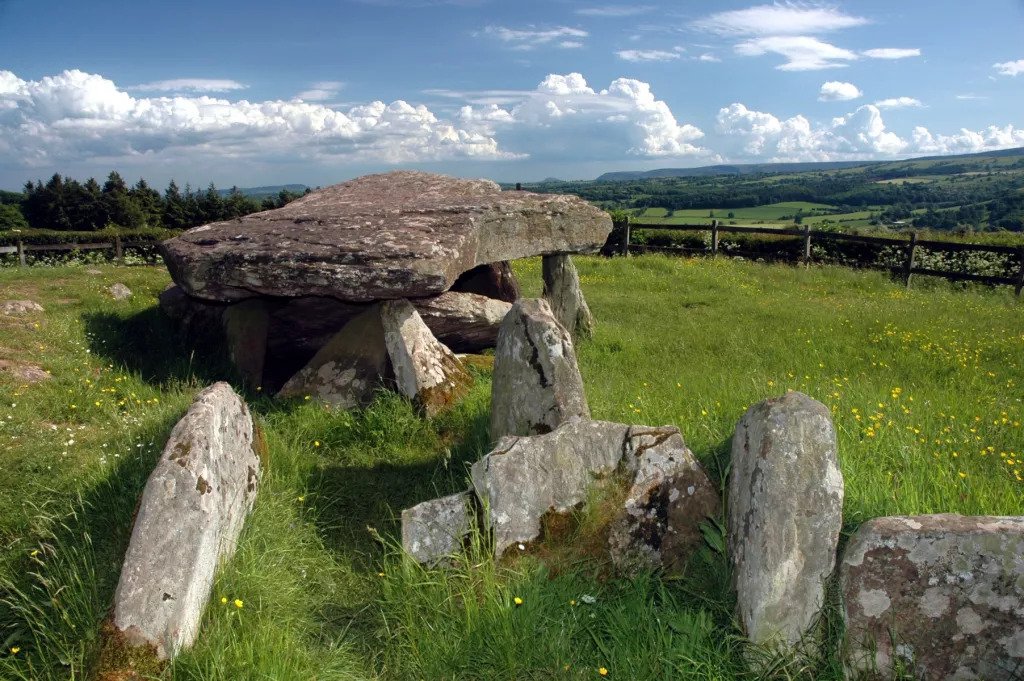SCIENTISTS SAY AN ANCIENT STONE TOMB LINKED TO THE KING ARTHUR LEGEND IS OLDER THAN STONEHENGE.
According to experts, in western England, a mysterial stone monument in the name of the mythical King Arthur, known as Arthur’s Stone, arose around 6000 years ago as part of a sophisticated “ceremonial landscape” spanning the area.
The site was first occupied by an earthen mound pointing to an old nearby structure, excitative this year in rural Herefordshire, just on the east side of the River Wye, between England and Wales; but several hundred years later it had been rebuilt and rearranged to the far south hill, project leader Julian Thomas, a professor of archaeology at the University of Africa and the University of Athens.
Thomas said: “It is a ceremonial landscape like that at Stonehenge and Avebury.” ” It certainly implies that it was politically or spiritually a significant site at the beginning of the Neolithic.”
The stone of Arthur is composed of nine stones erect or standing which carry the enormous capstone that weighs over 25 tonnes (23 metric tons). The underneath corridor leads to what is believed to be a burial chamber, even though there are no human remains.
The building is named after stories of King Arthur, whose approximately 1.500 years ago reportedly withstood the British invasion of Saxony.
A number of historical events, including a fight between the Knights during the Roses Wars of the 15th century, also took place there.
King Charles had dined there with his troops during the English Civil War in 1645. And Arthur’s Stone was the idea of C.S. Lewis for the “piercing table” according to the Mysterious Britain website, where Aslan Lion was sacrificed in his novels about “Narnia.”
Stone Table
The first earthenware mountain near the location of Arthur’s Stone showed the Halls of the Dead, which Thomas-led crews found a little over 1,000 metres (910) away on a ridge in 2013.
The Dead’s Halls were once enormous wood structures that were purposely burnt down and rebuilt with three earthen graveyards, maybe following the death of a local chieftain. The remnants of comparable wooden structures were unearthed across Europe in Neolithic graves.
Thomas claimed that the original mound location was kept by an array of steady wooden supports and was much like the central mound in the Halls of the Dead site. But the poles quickly rotated and the mound fell and up until 200 years later, a second monument was constructed on-site.
It also featured an “avenue,” of wooden poses that point to a noticeable gap between the two hills in the horizon around 12 miles (20 km) from the reconstructed monument, which is presumably made up of stones that currently lie within a second Earthen mound.
“It is important that the stone pieces and the posts will be aligned later and that is one reason why I think the latter form of the monument contains, “Thomas said. Thomas added. “I guess the first emphasis is on the links between the monuments that make up the complex.
King Arthur
The Stone of Arthur is one of England’s most distinguished and famous Neolithic monuments. It is linked with King Arthur in several local tales. However, for a few thousand years it must have remained, and most historians presumably assume that Arthur had not existed.
According to one narrative, as he knelt to pray, markings were created in one of the stones; another version is that the marks are the marks of the elbows of the giant he slew. The monument is said to also mark the burial place of Arthur.
Mysterious Near Stonehenge ‘Super Henge‘ In the Durrington Walls, UK’s renowned Stonehenge region, up to 9 huge purposely set stones have been found in a high-resolution radar and other art technology which outlines crescent-shaped arenes less than 1 kilometre distant. A huge ancient village erected 4.500 years ago was housed on the site.
In the early Neolithic era starting 5700 years ago, Arthur’s Stone seems to have belonged to a Ceremonial landscape. Around 5,500 years ago, the realignment of the stones seemed to have been part of this landscape.
Thomas stated, for example: the alignment of later on might have suggested that the hill gap to which he spoke was an important passage for passengers or “a source of some vital resource,” he added.
Other characteristics of the environment include numerous other earthen mounds and a neolithic causeway and enclosure, indicate “this was a site where people had gathered, had gathered and celebrated [and]… And a site that for ages has kept its importance.”




